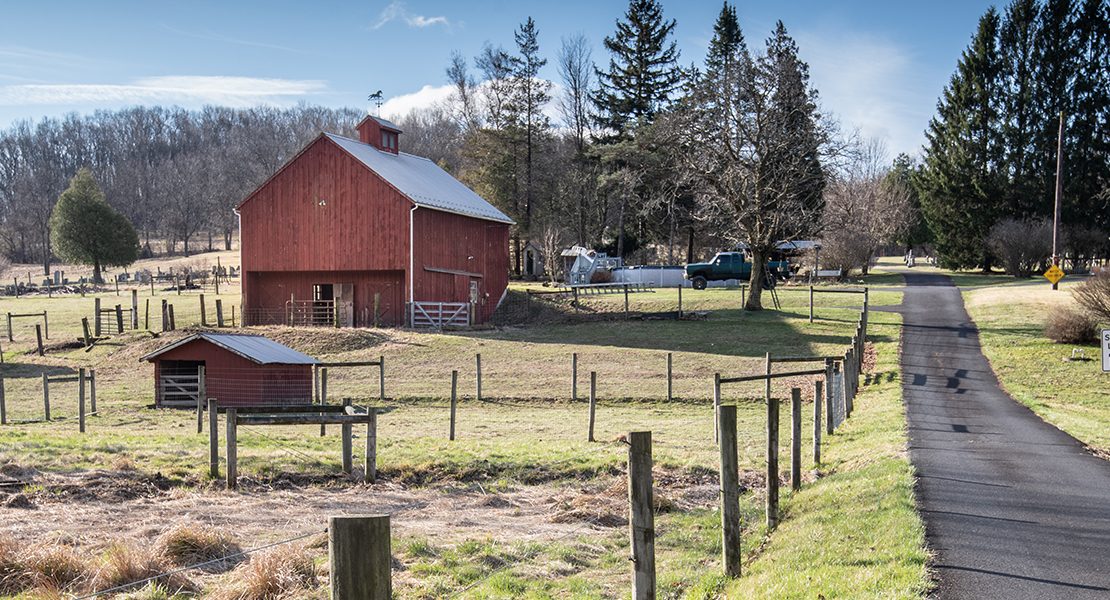All Roads Lead to Springtown

Just south of Hellertown in northern Bucks County where Routes 412 and 212 converge lies the small, quiet village of Springtown, where sturdy pre-Revolutionary War through 19th-century structures, barns, and outbuildings present tangible reminders of its agrarian, independent past.
Designated as a National Historic District in 2007, Springtown has about 30 extant structures that date from 1739 to the late 1800s. If you spend time with Scott Strock, a Springtown native whose family’s roots go back to its earliest beginnings, you’ll discover a great deal about this scenic village.
Strock and his wife, Diane, also born and raised in Springtown, now live in western New York State. But Springtown, nestled against the south slope of a range of hills that define the boundary between Bucks and Northampton counties, is never far from their thoughts as they visit their ancestral home regularly.
“When the time comes, Diane and I will be buried in the Springtown Cemetery, and I will be the fifth consecutive generation buried there, dating back to the very beginning of that cemetery in 1873,” he says. “Our ancestry in the Bucks/Northampton area goes back well before that. Diane and I have 29 direct ancestors who are considered Revolutionary War soldiers, and we had some notable ancestors in surrounding counties even before that.”
Raised in a home at Church and Center streets in town, not far from the historic early-19th-century Eakin farm where his father grew strawberries, tomatoes, and other truck crops, Strock can trace his ancestry back to those who built or owned about five of the buildings that are part of the Springtown Historic District. They include the former White Horse Tavern, Kookert’s Tavern, and the Mansion House, built by Conrad Hess (1745-1832), a fifth great-grandfather of both Scott and Diane Strock.
“Springtown, like most old small towns, used to be fairly independent with butchers, general stores, blacksmith, coach maker, a newspaper and later even two car dealers,” Strock says. “Now it is mostly a bedroom community like everywhere with just a few services. Like most of southeastern Pennsylvania, although settled by the British, Pennsylvania Germans overwhelmed the area prior to the Revolutionary War. I’ve found that most everyone who is descended from any of those early Pennsylvania Germans are at least distant cousins.”
Strock has vivid memories of his boyhood days in Springtown, riding his bike through the countryside, and never worrying much about anything. “It was still rural. We never locked any doors,” he recalls. “You just didn’t think twice about doing that. Now you learn to appreciate those days and realize how unusual it was.”
Abundant fresh water springs that gave the village its name flow into Silver Creek, supported early settlement and led to industries such as a tannery and fish hatcheries. Strock says residents would not hesitate to fill containers of fresh, cool drinking water from springs that would never run dry, even in the hardest of droughts. “It was crystal clear and pure,” he says.
For a taste of Springtown’s past, the Springtown Inn, 3258 Main St., allows guests to step back in time while enjoying a first-class menu and hospitality. A former stagecoach stop built in 1830, the inn maintains much of its original charm—hardwood floors, stone walls and stained glass, two working fireplaces, and historic photographs over the bar.
Following in the footsteps of a long lineage of owners, Bobbie Gianguzzi, inn manager and a veteran of the restaurant business, and Carol and Douglas Tweed, became the owners of the inn in December 2018.
“We wanted to keep it a restaurant in the country and maintain the quality and everything about it,” Carol Tweed says.
“We’re not a chain restaurant,” Gianguzzi quickly adds.
In addition to the regular menu, the weekly schedule includes a buffet every Monday night, steak night on Thursday, a happy hour on Monday, Thursday and Friday, and Seafood Sundays. Steaks are the specialty. When asked what they’d recommend most from the menu, Filet Mignon Oscar topped the list.
“It’s just delicious and tender and you get the crab meat with a chef-made hollandaise sauce with grilled asparagus and potato croquettes,” Gianguzzi says enthusiastically.
Beyond the menu, the inn owners offer hometown hospitality, always striving to make connections. “We try to get to know each of our customers, what they drink and what they like to eat,” Tweed says. “They’re not a number. They’re part of our family and part of what makes Springtown special.”
After dinner at the Springtown Inn, guests can take in the sights of the village’s bygone era. “When you lived in Springtown as a kid, you didn’t appreciate it, you just took it all for granted,” Strock says. “But the history is all around you.”
TRAVEL TO THE PAST WITH DIANE AND SCOTT STROCK
Originally scheduled for April, but now postponed to October 18 at 2 p.m, Springfield Township Historical Society’s Church School, at 2165 Route 212 in Pleasant Valley (GPS Coopersburg)
Diane and Scott will discuss Springtown genealogy as part of the Springfield Township Historical Society’s program schedule. The event is free. This program will be chock full of fascinating information, thoroughly prepared by a couple who
have a passion for family history and Springtown.












